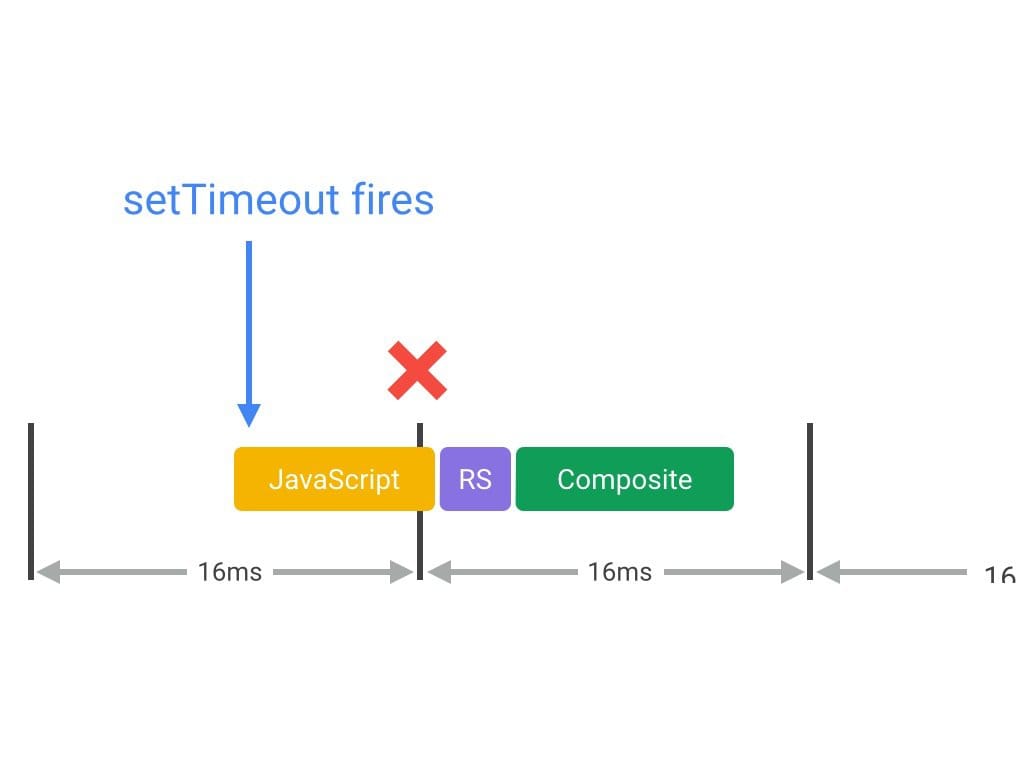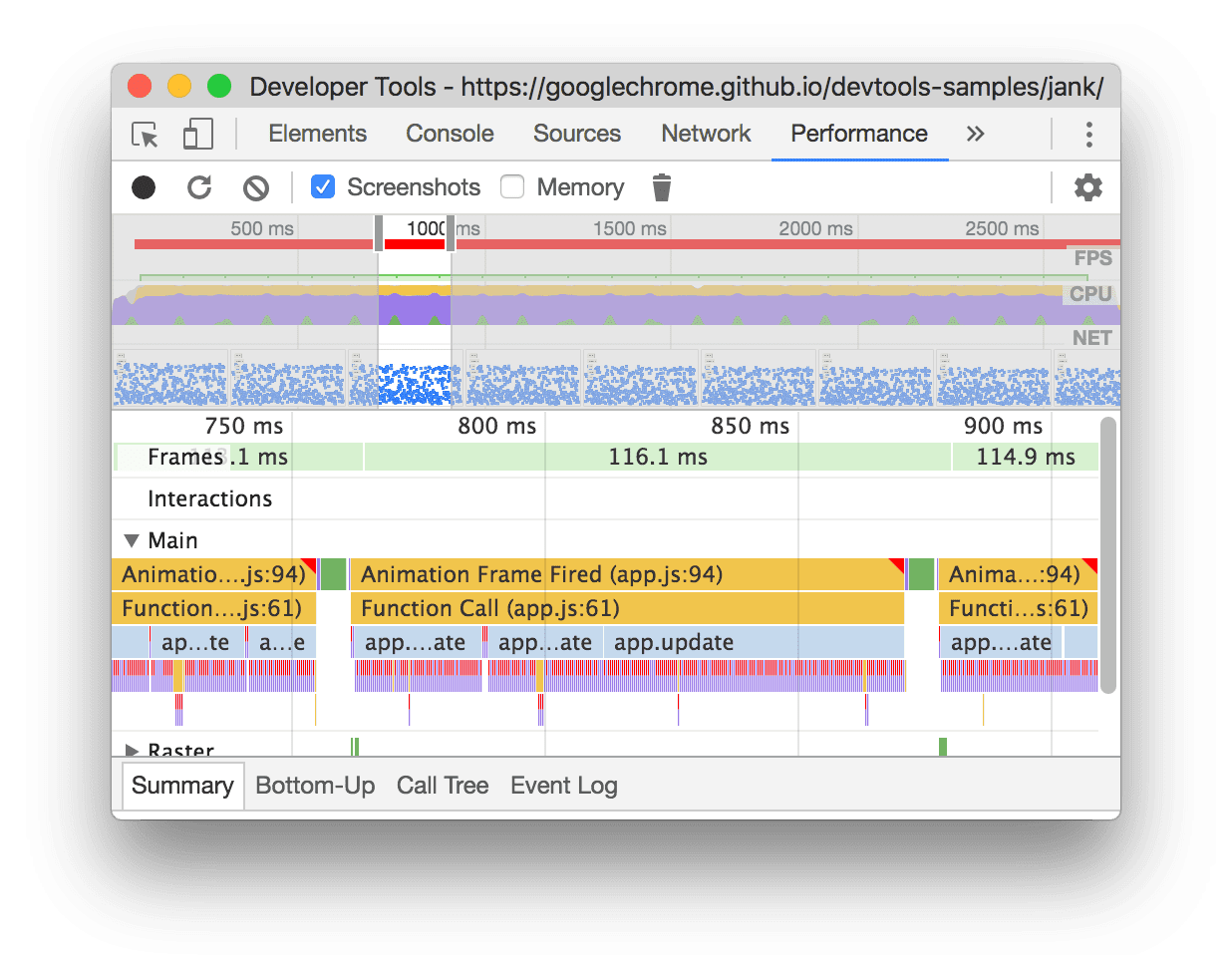JavaScript often triggers visual changes. Sometimes that's directly through style manipulations, and sometimes it's calculations that result in visual changes, like searching or sorting data. Badly-timed or long-running JavaScript is a common cause of performance issues. You should look to minimize its impact where you can.
JavaScript often triggers visual changes. Sometimes that's directly through style manipulations, and sometimes it's calculations that result in visual changes, like searching or sorting data. Badly-timed or long-running JavaScript is a common cause of performance issues. You should look to minimize its impact where you can.
JavaScript performance profiling can be something of an art, because the JavaScript you write is nothing like the code that is actually executed. Modern browsers use JIT compilers and all manner of optimizations and tricks to try and give you the fastest possible execution, and this substantially changes the dynamics of the code.
With all that said, however, there are some things you can definitely do to help your apps execute JavaScript well.
Summary
- Avoid setTimeout or setInterval for visual updates; always use requestAnimationFrame instead.
- Move long-running JavaScript off the main thread to Web Workers.
- Use micro-tasks to make DOM changes over several frames.
- Use Chrome DevTools’ Timeline and JavaScript Profiler to assess the impact of JavaScript.
Use requestAnimationFrame for visual changes
When visual changes are happening on screen you want to do your work at the right time for the
browser, which is right at the start of the frame. The only way to guarantee that your JavaScript
will run at the start of a frame is to use requestAnimationFrame.
/**
* If run as a requestAnimationFrame callback, this
* will be run at the start of the frame.
*/
function updateScreen(time) {
// Make visual updates here.
}
requestAnimationFrame(updateScreen);
Frameworks or samples may use setTimeout or setInterval to do visual changes like animations,
but the problem with this is that the callback will run at some point in the frame, possibly right
at the end, and that can often have the effect of causing us to miss a frame, resulting in jank.

In fact, jQuery used to use setTimeout for its animate behavior. It was changed to use
requestAnimationFrame in version 3.
If you are using older version of jQuery, you can
patch it to use requestAnimationFrame,
which is strongly advised.
Reduce complexity or use Web Workers
JavaScript runs on the browser’s main thread, right alongside style calculations, layout, and, in many cases, paint. If your JavaScript runs for a long time, it will block these other tasks, potentially causing frames to be missed.
You should be tactical about when JavaScript runs, and for how long. For example, if you’re in an animation like scrolling, you should ideally be looking to keep your JavaScript to something in the region of 3-4ms. Any longer than that and you risk taking up too much time. If you’re in an idle period, you can afford to be more relaxed about the time taken.
In many cases you can move pure computational work to Web Workers, if, for example, it doesn’t require DOM access. Data manipulation or traversal, like sorting or searching, are often good fits for this model, as are loading and model generation.
var dataSortWorker = new Worker("sort-worker.js");
dataSortWorker.postMesssage(dataToSort);
// The main thread is now free to continue working on other things...
dataSortWorker.addEventListener('message', function(evt) {
var sortedData = evt.data;
// Update data on screen...
});
Not all work can fit this model: Web Workers do not have DOM access. Where your work must be on the main thread, consider a batching approach, where you segment the larger task into micro-tasks, each taking no longer than a few milliseconds, and run inside of requestAnimationFrame handlers across each frame.
There are UX and UI consequences to this approach, and you will need to ensure that the user knows that a task is being processed, either by using a progress or activity indicator. In any case this approach will keep your app's main thread free, helping it to stay responsive to user interactions.
Know your JavaScript’s “frame tax”
When assessing a framework, library, or your own code, it’s important to assess how much it costs to run the JavaScript code on a frame-by-frame basis. This is especially important when doing performance-critical animation work like transitioning or scrolling.
The Performance panel of Chrome DevTools is the best way to measure your JavaScript's cost. Typically you get low-level records like this:

The Main section provides a flame chart of JavaScript calls so you can analyze exactly which functions were called and how long each took.
Armed with this information you can assess the performance impact of the JavaScript on your application, and begin to find and fix any hotspots where functions are taking too long to execute. As mentioned earlier you should seek to either remove long-running JavaScript, or, if that’s not possible, move it to a Web Worker freeing up the main thread to continue on with other tasks.
See Get Started With Analyzing Runtime Performance to learn how to use the Performance panel.
Avoid micro-optimizing your JavaScript
It may be cool to know that the browser can execute one version of a thing 100 times faster than
another thing, like that requesting an element’s offsetTop is faster than computing
getBoundingClientRect(), but it’s almost always true that you’ll only be calling functions like
these a small number of times per frame, so it’s normally wasted effort to focus on this aspect of
JavaScript’s performance. You'll typically only save fractions of milliseconds.
If you’re making a game, or a computationally expensive application, then you’re likely an exception to this guidance, as you’ll be typically fitting a lot of computation into a single frame, and in that case everything helps.
In short, you should be very wary of micro-optimizations because they won’t typically map to the kind of application you’re building.
